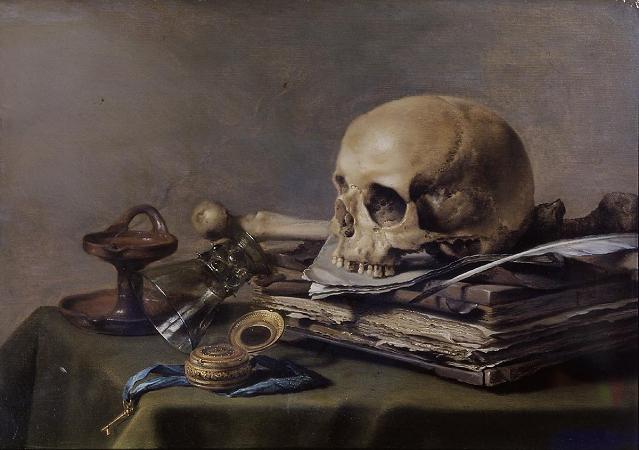Vanitas Still Life. A vanitas is a symbolic work of art showing the transience of life, the futility of pleasure, and the certainty of death, often contrasting symbols of wealth and symbols of ephemerality and death. Best-known are vanitas still lifes, a common genre in Netherlandish art of the 16th and 17th centuries; they have also been created at other times and in other media and genres. The Latin noun vanitas means 'emptiness', 'futility', or 'worthlessness', the traditional Christian view being that earthly goods and pursuits are transient and worthless. It alludes to Ecclesiastes, where vanitas translates the Hebrew word hevel, which also includes the concept of transitoriness. Vanitas themes were common in medieval funerary art, with most surviving examples in sculpture. By the 15th century, these could be extremely morbid and explicit, reflecting an increased obsession with death and decay also seen in the Ars moriendi, the Danse Macabre, and the overlapping motif of the Memento mori. From the Renaissance such motifs gradually became more indirect and, as the still-life genre became popular, found a home there. Paintings executed in the vanitas style were meant to remind viewers of the transience of life, the futility of pleasure, and the certainty of death. They also provided a moral justification for painting attractive objects. Common vanitas symbols include skulls, which are a reminder of the certainty of death; rotten fruit; bubbles; smoke, watches, and hourglasses; and musical instruments. Fruit, flowers and butterflies can be interpreted in the same way, and a peeled lemon was, like life, attractive to look at but bitter to taste. Art historians debate how much, and how seriously, the vanitas theme is implied in still-life paintings without explicit imagery such as a skull. As in much moralistic genre painting, the enjoyment evoked by the sensuous depiction of the subject is in a certain conflict with the moralistic message. Composition of flowers is a less obvious style of Vanitas by Abraham Mignon in the National Museum, Warsaw. Barely visible amid vivid and perilous nature, a bird skeleton is a symbol of vanity and shortness of life. The first movement in composer Robert Schumann's 5 Pieces in a Folk Style, for Cello and Piano, Op. 102 is entitled Vanitas vanitatum: Mit Humor. Vanitas vanitatum is the title of an oratorio written by an Italian Baroque composer Giacomo Carissimi. Composer Richard Barrett's Vanity, for orchestra, is greatly inspired by this movement. Vanitas is the seventh album by British Extreme Metal band Anaal Nathrakh. Vanitas is the name of a character from the Kingdom Hearts franchise.
more...














